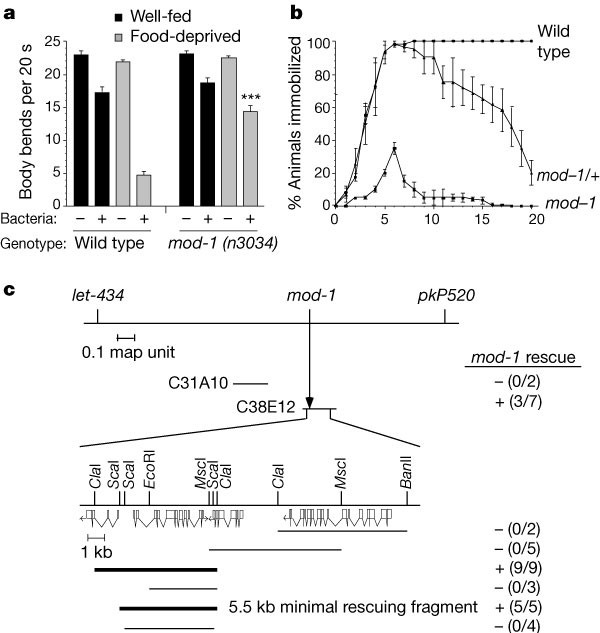
- Select a language for the TTS:
- UK English Female
- UK English Male
- US English Female
- US English Male
- Australian Female
- Australian Male
- Language selected: (auto detect) - EN
Play all audios:
ABSTRACT The neurotransmitter and neuromodulator serotonin (5-HT) functions by binding either to metabotropic G-protein-coupled receptors (for example, 5-HT1, 5-HT2, 5-HT4 to 5-HT7), which
mediate ‘slow’ modulatory responses through numerous second messenger pathways1, or to the ionotropic 5-HT3 receptor, a non-selective cation channel that mediates ‘fast’ membrane
depolarizations2. Here we report that the gene _mod-1_ (for modulation of locomotion defective) from the nematode _Caenorhabditis elegans_ encodes a new type of ionotropic 5-HT receptor, a
5-HT-gated chloride channel. The predicted MOD-1 protein is similar to members of the nicotinic acetylcholine receptor family of ligand-gated ion channels, in particular to GABA
(γ-aminobutyric acid)- and glycine-gated chloride channels. The MOD-1 channel has distinctive ion selectivity and pharmacological properties. The reversal potential of the MOD-1 channel is
dependent on the concentration of chloride ions but not of cations. The MOD-1 channel is not blocked by calcium ions or 5-HT3a-specific antagonists but is inhibited by the metabotropic 5-HT
receptor antagonists mianserin and methiothepin. _mod-1_ mutant animals are defective in a 5-HT-mediated experience-dependent behaviour3 and are resistant to exogenous 5-HT, confirming that
MOD-1 functions as a 5-HT receptor _ in vivo_. Access through your institution Buy or subscribe This is a preview of subscription content, access via your institution ACCESS OPTIONS Access
through your institution Subscribe to this journal Receive 51 print issues and online access $199.00 per year only $3.90 per issue Learn more Buy this article * Purchase on SpringerLink *
Instant access to full article PDF Buy now Prices may be subject to local taxes which are calculated during checkout ADDITIONAL ACCESS OPTIONS: * Log in * Learn about institutional
subscriptions * Read our FAQs * Contact customer support SIMILAR CONTENT BEING VIEWED BY OTHERS A SPECIFIC FOLATE ACTIVATES SEROTONERGIC NEURONS TO CONTROL _C. ELEGANS_ BEHAVIOR Article Open
access 30 September 2024 STRUCTURAL BASIS FOR EXCITATORY NEUROPEPTIDE SIGNALING Article Open access 09 February 2024 CODING PRINCIPLES AND MECHANISMS OF SEROTONERGIC TRANSMISSION MODES
Article Open access 22 February 2025 REFERENCES * Martin, G. R., Eglen, R. M., Hamblin, M. W., Hoyer, D. & Yocca, F. The structure and signalling properties of 5-HT receptors: an endless
diversity? _Trends Pharmacol. Sci. _ 19, 2–4 (1998 ). Article CAS PubMed Google Scholar * Maricq, A. V., Peterson, A. S., Brake, A. J., Myers, R. M. & Julius, D. Primary structure
and functional expression of the 5HT3 receptor, a serotonin-gated ion channel. _Science_ 254, 432–437 (1991). Article ADS CAS PubMed Google Scholar * Sawin, E. R., Ranganathan, R. &
Horvitz, H. R. _C. elegans_ locomotory rate is modulated by the environment through a dopaminergic pathway and by experience through a serotonergic pathway. _Neuron_ 26, 619– 631 (2000).
Article CAS PubMed Google Scholar * Horvitz, H. R., Chalfie, M., Trent, C., Sulston, J. E. & Evans, P. D. Serotonin and octopamine in the nematode _Caenorhabditis elegans_. _Science_
216, 1012– 1014 (1982). Article ADS CAS PubMed Google Scholar * The _C. elegans_ Sequencing Consortium. Genome sequence of the nematode _C. elegans_: a platform for investigating
biology. _Science_ 282, 2012– 2018 (1998). Article ADS Google Scholar * Krause, M. & Hirsh, D. A trans-spliced leader sequence on actin mRNA in _C. elegans_. _Cell_ 49, 753–761
(1987). Article CAS PubMed PubMed Central Google Scholar * Liu, L. X. _et al._ High-throughput isolation of _Caenorhabditis elegans_ deletion mutants. _Genome Res._ 9, 859– 867 (1999).
Article CAS PubMed PubMed Central Google Scholar * Jansen, G., Hazendonk, E., Thijssen, K. L. & Plasterk, R. H. Reverse genetics by chemical mutagenesis in _Caenorhabditis elegans_.
_Nature Genet._ 17, 119– 121 (1997). Article CAS PubMed Google Scholar * Sumikawa, K. & Gehle, V. M. Assembly of mutant subunits of the nicotinic acetylcholine receptor lacking the
conserved disulfide loop structure. _J. Biol. Chem._ 267, 6286– 6290 (1992). CAS PubMed Google Scholar * Karlin, A. & Akabas, M. H. Toward a structural basis for the function of
nicotinic acetylcholine receptors and their cousins. _ Neuron_ 15, 1231–1244 ( 1995). Article CAS PubMed Google Scholar * Cooper, J. R., Bloom, F. E. & Roth, R. H. _The Biochemical
Basis of Neuropharmacology_ (Oxford Univ. Press, New York, 1996). Google Scholar * Hardie, R. C. A histamine-activated chloride channel involved in neurotransmission at a photoreceptor
synapse. _Nature_ 339, 704– 706 (1989). Article ADS CAS PubMed Google Scholar * McClintock, T. S. & Ache, B. W. Histamine directly gates a chloride channel in lobster olfactory
receptor neurons. _ Proc. Natl Acad. Sci. USA_ 86, 8137– 8141 (1989). Article ADS CAS PubMed PubMed Central Google Scholar * Cully, D. F. _ et al._ Cloning of an avermectin-sensitive
glutamate-gated chloride channel from _Caenorhabditis elegans_. _Nature_ 371, 707–711 (1994). Article ADS CAS PubMed Google Scholar * Adelsberger, H., Lepier, A. & Dudel, J.
Activation of rat recombinant α1β 2γ2S GABAA receptor by the insecticide ivermectin. _Eur. J. Pharmacol._ 394, 163– 170 (2000). Article CAS PubMed Google Scholar * Krause, R. M. _ et
al._ Ivermectin: a positive allosteric effector of the α7 neuronal nicotinic acetylcholine receptor. _Mol. Pharmacol._ 53, 283–294 (1998). Article CAS PubMed Google Scholar * Davies, P.
A. _ et al._ The 5-HT3B subunit is a major determinant of serotonin-receptor function. _Nature_ 397, 359– 363 (1999). Article ADS CAS PubMed Google Scholar * Downie, D. L. _ et al._
Pharmacological characterization of the apparent splice variants of the murine 5-HT3 R-A subunit expressed in _Xenopus laevis _ oocytes. _Neuropharmacology_ 33, 473– 482 (1994). Article CAS
PubMed Google Scholar * Aizenberg, D. _ et al._ Mianserin, a 5-HT2a/2c and alpha 2 antagonist, in the treatment of sexual dysfunction induced by serotonin reuptake inhibitors. _ Clin.
Neuropharmacol._ 20, 210–214 (1997). Article CAS PubMed Google Scholar * Granas, C. & Larhammar, D. Identification of an amino acid residue important for binding of methiothepin and
sumatriptan to the human 5-HT(1B) receptor. _Eur. J. Pharmacol._ 380, 171–181 (1999). Article CAS PubMed Google Scholar * Weber, W. Ion currents of _Xenopus laevis_ oocytes: state of the
art. _ Biochim. Biophys. Acta._ 1421, 213– 233 (1999). Article CAS PubMed Google Scholar * Bormann, J., Hamill, O. P. & Sakmann, B. Mechanism of anion permeation through channels
gated by glycine and gamma-aminobutyric acid in mouse cultured spinal neurones. _J. Physiol. (Lond.)_ 385, 243– 286 (1987). Article CAS Google Scholar * Chalfie, M., Tu, Y., Euskirchen,
G., Ward, W. W. & Prasher, D. C. Green fluorescent protein as a marker for gene expression. _Science_ 263, 802–805 (1994). Article ADS CAS PubMed Google Scholar * Shaham, S. &
Horvitz, H. R. Developing _Caenorhabditis elegans_ neurons may contain both cell-death protecture and killer activities. _Genes Dev._ 10, 578–591 (1996). Article CAS PubMed Google Scholar
* Lessmann, V. & Dietzel, I. D. Development of serotonin-induced ion currents in identified embryonic Retzius cells from the medicinal leech (_Hirudo medicinalis_). _J. Neurosci._ 11,
800–809 (1991). Article CAS PubMed PubMed Central Google Scholar * Lessmann, V. & Dietzel, I. D. Two kinetically distinct 5-hydroxytryptamine-activated Cl- conductances at Retzius
P-cell synapses of the medicinal leech. _J. Neurosci._ 15, 1496– 1505 (1995). Article CAS PubMed PubMed Central Google Scholar * Brenner, S. The genetics of _Caenorhabditis elegans_.
_Genetics_ 77, 71–94 (1974). CAS PubMed PubMed Central Google Scholar * Mello, C. C., Kramer, J. M., Stinchcomb, D. & Ambros, V. Efficient gene transfer in _C. elegans_:
extrachromosomal maintenance and integration of transforming sequences. _EMBO J._ 10, 3959–3970 (1991). Article CAS PubMed PubMed Central Google Scholar * Morrill, J. A. & Cannon,
S. C. Effects of mutations causing hypokalaemic periodic paralysis on the skeletal muscle L-type Ca2+ channel expressed in _Xenopus laevis_ oocytes. _ J. Physiol. (Lond.)_ 520, 321–336
(1999). Article CAS Google Scholar * Hayward, L. J., Brown, R. H. Jr & Cannon, S. C. Inactivation defects caused by myotonia-associated mutations in the sodium channel III-IV linker.
_J. Gen. Physiol. _ 107, 559–576 ( 1996). Article CAS PubMed Google Scholar Download references ACKNOWLEDGEMENTS We thank N. Buttner, D. Omura and P. Reddien for suggestions concerning
this manuscript; G. Moulder and R. Barstead for help in isolating the _ mod-1(ok103)_ allele; L. Liu and C. Johnson for sharing the _ mod-1(nr2043)_ allele before publication; and D. Julius
for the 5-HT3a cDNA clone. This work was supported by a grant from the United States Public Health Service (H.R.H.). R.R. is supported by a Howard Hughes Medical Institute predoctoral
fellowship. H.R.H. is an Investigator of the Howard Hughes Medical Institute. AUTHOR INFORMATION AUTHORS AND AFFILIATIONS * Howard Hughes Medical Institute Department of Biology, Room
68-425, Massachusetts Institute of Technology, 77 Massachusetts Avenue, Cambridge, 02139, Massachusetts, USA Rajesh Ranganathan & H. Robert Horvitz * Department of Neurobiology, and
Department of Neurology Massachusetts General Hospital, Harvard Medical School, Boston, Massachusetts 02115, Boston, 02114, Massachusetts , USA Stephen C. Cannon Authors * Rajesh Ranganathan
View author publications You can also search for this author inPubMed Google Scholar * Stephen C. Cannon View author publications You can also search for this author inPubMed Google Scholar
* H. Robert Horvitz View author publications You can also search for this author inPubMed Google Scholar CORRESPONDING AUTHOR Correspondence to H. Robert Horvitz. SUPPLEMENTARY INFORMATION
SUPPLEMENTARY INFORMATION RIGHTS AND PERMISSIONS Reprints and permissions ABOUT THIS ARTICLE CITE THIS ARTICLE Ranganathan, R., Cannon, S. & Horvitz, H. MOD-1 is a serotonin-gated
chloride channel that modulates locomotory behaviour in _C. elegans_. _Nature_ 408, 470–475 (2000). https://doi.org/10.1038/35044083 Download citation * Received: 28 July 2000 * Accepted: 11
September 2000 * Issue Date: 23 November 2000 * DOI: https://doi.org/10.1038/35044083 SHARE THIS ARTICLE Anyone you share the following link with will be able to read this content: Get
shareable link Sorry, a shareable link is not currently available for this article. Copy to clipboard Provided by the Springer Nature SharedIt content-sharing initiative








